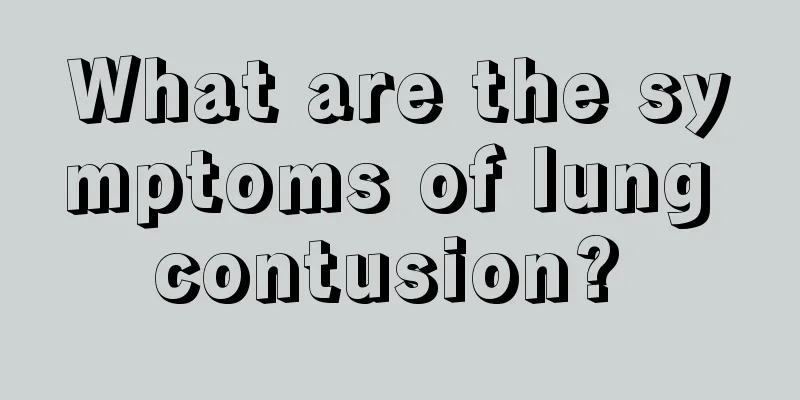What are the symptoms of lung contusion?

|
Pulmonary contusion is a common lung disease, but many friends are not aware of this disease. There are many causes of lung contusion, such as compression or impact caused by external force. The more obvious symptoms of pulmonary contusion are chest pain, chest tightness, and shortness of breath. These feelings are also very obvious to patients, so they can be discovered in time. Pulmonary contusion is a common injury to the lung parenchyma, mostly caused by rapid blunt trauma, such as traffic accidents, collisions, crushing and falls. The incidence rate accounts for about 30% to 75% of blunt chest injuries, but it is often ignored or missed due to insufficient understanding, insensitive examination techniques or being masked by other chest injuries. Disease Overview Pulmonary contusions mostly occur in patients with blunt trauma, often accompanied by severe bony thorax injuries, such as flail chest; they may also be caused by high-pressure air waves or water waves generated by the explosion impacting the chest wall and colliding with lung tissue, which is called pulmonary blast injury. Pulmonary contusion can cause damage to lung cells and blood vessels, and bleeding into the lung parenchyma. More importantly, the inflammatory response after contusion promotes the deposition of inflammatory cells and the release of inflammatory mediators, increases the permeability of pulmonary capillaries, and causes the intravascular fluid to seep into the extravascular space, accumulate in the alveoli and pulmonary interstitium, causing ventilation-perfusion imbalance and hypoxemia. Clinical manifestations Due to the different severity and extent of pulmonary contusion, the clinical manifestations vary greatly. In mild cases, there are only chest pain, chest tightness, shortness of breath, cough and bloody sputum, and scattered rales are heard on auscultation. There are patchy shadows on the chest X-ray (often reported as traumatic wet lung), which can be completely absorbed in 1 to 2 days. Blood gas may be normal. Some people call it pulmonary concussion. In severe cases, there are obvious breathing difficulties, cyanosis, bloody foamy sputum, tachycardia and hypotension. Auscultation reveals widespread rales, decreased to absent breath sounds, or tubular breath sounds. Arterial blood gas analysis is of reference value before hypoxemia is revealed on chest X-ray. Chest X-ray is an important means of diagnosing pulmonary contusion. In about 70% of cases, the changes appear within 1 hour after injury, and in 30% of cases, they may be delayed to 4 to 6 hours after injury. The range may be from a small localized area to one or both sides, and the degree may range from spotty infiltration, diffuse or local spotty fusion infiltration, to diffuse large infiltration or consolidation shadows in one or both lungs. After treatment, it usually starts to be absorbed 2 to 3 days after the injury, and it takes more than 2 to 3 weeks for complete absorption. In recent years, through serial CT examinations, new pathological viewpoints on pulmonary contusion have been proposed. The contusion shown on X-ray films appears on CT films as a laceration of the lung parenchyma and an alveolar hemorrhage surrounding the laceration without any pulmonary interstitial damage. Disease treatment Minor pulmonary contusions should also be treated. Severe pulmonary contusion is the most common factor causing acute respiratory failure after chest trauma. Treatment is to maintain respiratory and circulatory functions and appropriately deal with associated injuries. Flail chest often has varying degrees of pulmonary contusion. The pathophysiological changes depend to a large extent on the pulmonary contusion. When the signs of acute respiratory failure appear, mechanical ventilation should be given in a timely manner. At present, the use of corticosteroids is no longer emphasized as in the past. For those with hypovolemic shock, blood volume should still be replenished in time, the ratio of crystalloid and colloid fluids should be reasonably matched, normal colloid osmotic pressure and total osmotic pressure should be maintained, and negative fluid balance should be maintained thereafter, with a daily volume of 1600 to 1800 ml. |
<<: What are the symptoms of burn wound infection?
>>: What to eat after egg retrieval to restore ovaries
Recommend
Early understanding of bone cancer symptoms is beneficial to treatment
You can't be sick. Bone cancer is caused by i...
What are the signs that the opposite sex likes you
For a man and a woman to become a couple, it is v...
Effect of surgical treatment of multiple thyroid cysts
A healthy body can always bring you many benefits...
What to do if your ears hurt when you dig them
The ears and belly buttons are areas of the human...
Which women are prone to breast cancer
The following types of women are prone to breast ...
How to make hair smooth and not frizzy?
Whether boys or girls, they all hope that their h...
What is exercise-induced abdominal pain?
Some friends may exercise after eating, or suffer...
What are the main plants that absorb formaldehyde
We all know that many newly renovated houses have...
What are the early causes of varicose veins in the lower limbs?
Varicose veins in the lower limbs are a disease t...
What should a pregnant woman do if she wants to eat spicy hot pot?
In the southwest of our country, people especiall...
What are the factors that lead to liver cancer? These 5 are the causes of liver cancer
Liver cancer is one of the diseases that is parti...
What are the dangers of cheap lipstick
There are so many colors and types of lipsticks o...
Venous blood drawing steps
When we have a physical examination or go to the ...
Treatment costs for early liver cancer
How much does it cost to treat liver cancer? Live...
What are the side effects of hair transplantation
There is a lot of social pressure nowadays. Many ...









